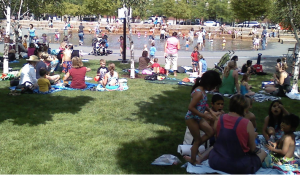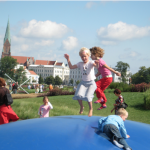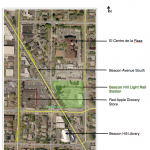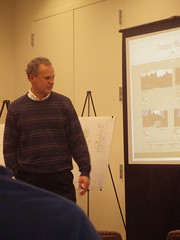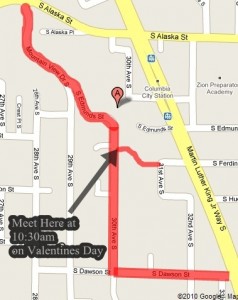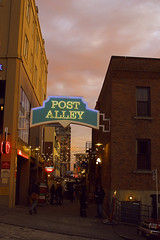
By Glenn Herlihy
Pictured here is the first of several design options for the proposed Jefferson Park Food Forest. First and foremost, this would be a community garden where neighbors could interact and grow their own food. It would be a garden run and managed by community members and citywide supporters, to achieve a bit more food security by having a local food production facility. Second, it’s about creating a healthy park environment for all to enjoy. Third, it’s about promoting gardening as a sustainable recreation. Please remember this is a “design in process” as we look forward to more input from the community.
A food forest is a gardening technique or land management system modeled after a woodland ecosystem, but which substitutes trees, shrubs, herbs, and vegetables which have a higher yield for humans. It’s a polyculture method (as opposed to monoculture) of planting in guilds (combinations) that nurture each other through nutrient—soil fixing, attracting pollinators and self-mulching. The result is an edible woodland with meadows, pathways, and a grand source of fresh air.
The Jefferson Park Food Forest is located on the southern part of the western slope of Jefferson Park and covers about four acres. In the map pictured here, 15th Avenue South is shown on the left (west), South Dakota Street is near the bottom (south) and the reservoir playfield is up on the right (east). Seasonal water collection is shown in blue. The blue areas would be wet in the rainy season and dry in the summer. Paved areas are shown in orange with 16th Avenue South serving as a water collecting swale. Trees are shown in green with most of the forest on the hill to the east. The green areas are swaths of mixed plantings mostly consisting of berries and natives. Green colored P-Patches have curved paths (orange) through them. The yellow circle is a community shade structure with tool shed sub-grade.
The City-adopted North Beacon Hill Neighborhood Plan (2000) for this property calls for a forested, naturalized terrace with pedestrian pathways, educational facilities, and view accesses (Action PE2). This project builds on that adopted concept to create a food forest that is natural and educational, but more focused in producing food with recreational gardening. It also builds on the adopted recommendation in our neighborhood plan for distinctive park entry improvements in this area (Action PE4). The Jefferson Park Alliance did outreach to the larger community at the last Beacon Hill Festival (2009) on this concept and received significant positive interest from people who would like to garden and support urban agriculture in the park.
We will be presenting this design and answering questions on April 1 at the North Beacon Hill Council meeting and at the 2010 Beacon Hill Festival on June 5. We have a Food Forest meeting scheduled for April 6, 7:00 pm at the Lawn Bowling Clubhouse (4103 Beacon Avenue South) if you would like to hear more. Thank You.
Glenn Herlihy is part of a group that is guiding the Food Forest proposal through the application process for the city’s Parks and Green Spaces Levy Opportunity Fund.
